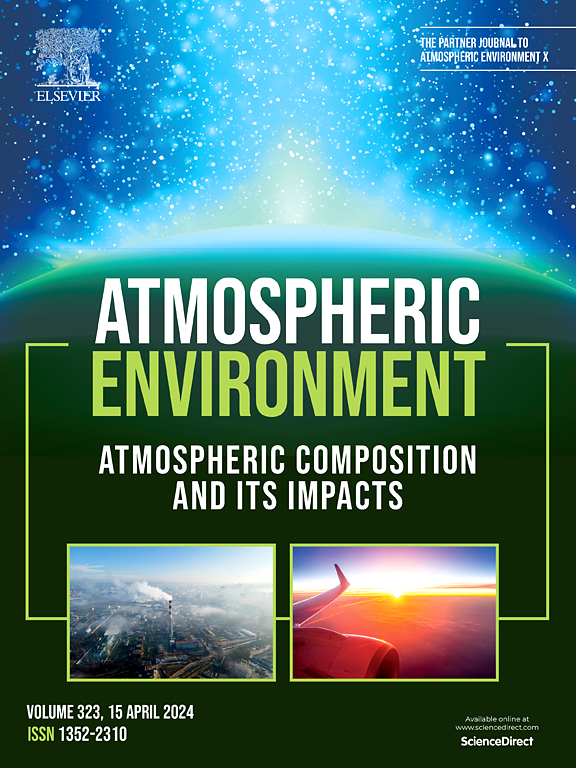Field observations of intermediate volatile organic compounds during haze events in three cities of northern China: Characteristics, sources and contributions to SOA formation
IF 4.2
2区 环境科学与生态学
Q2 ENVIRONMENTAL SCIENCES
引用次数: 0
Abstract
Intermediate volatile organic compounds (IVOCs) are the most important precursor of secondary organic aerosols (SOA) in the atmosphere, and there remains a deficiency of in-depth research regarding their concentrations, compositions, sources, and contribution to SOA. In this study, IVOCs and PM2.5 samples with high-temporal-resolution were collected during five winter haze episodes (defined as ZB-P1, ZB-P2, HEB-P1, HEB-P2, and ZK-P1) in three cities in northern China (Harbin, Zibo, and Zhoukou). Among the three sampling sites, Harbin (HEB) recorded the highest IVOCs (73.1 ± 20.9 μg/m3) and PM2.5 (193.5 ± 62.7 μg/m3), followed by Zhoukou (ZK) 57.5 ± 40.5 μg/m3 and 153.3 ± 78.4 μg/m3, and the lowest was Zibo (ZB) 24.4 ± 11.1 μg/m3 and 130.5 ± 53.2 μg/m3. During all haze episodes, IVOCUCM was the main component of IVOCs, but the second dominant components varied among the cities. IVOCn-alkanes was the dominant component in ZB, While IVOCPAHs in HEB, and IVOCb-alkanes in ZK. IVOCs exhibited a statistically significant inverse correlation with PM2.5 and SOAOC/EC (R = −0.48). It was found that IVOCPAHs exhibited the highest reactivity among the four categories and might contribute more significantly to SOA. For some n-alkanes and PAHs, Dodecane (n-C12), Heptadecane (n-C17), and Acenaphthene (ACE) were more reactive species. Using the PMF model and accounting for the photochemical loss of IVOCs, four sources of IVOCs were identified: gasoline exhaust, biomass/coal combustion, diesel-related emissions, and other sources (industrial sources and fireworks emissions). Biomass/coal combustion dominated (54.6 % and 58.1 %, observed and initial) in HEB, while industrial sources were predominant in ZB (63 % and 62.7 %), and fireworks were the main source in ZK (67.5 % and 68.2 %). Our results highlight that biomass/coal combustion, industrial sources and vehicle emissions remain the primary control objects. We also suggest that there is a need to strengthen the emission control strategy for PAHs in IVOCs.

中国北方三个城市雾霾期间中间挥发性有机化合物的野外观测:特征、来源及其对SOA形成的贡献
中间挥发性有机化合物(IVOCs)是大气中二次有机气溶胶(SOA)最重要的前体,对其浓度、组成、来源及其对SOA的贡献的深入研究仍然缺乏。本研究采集了中国北方3个城市(哈尔滨、淄博和周口)5次冬季雾霾事件(定义为ZB-P1、ZB-P2、HEB-P1、HEB-P2和ZK-P1)的高时间分辨率IVOCs和PM2.5样本。3个采样点中,哈尔滨(HEB)的IVOCs最高(73.1±20.9 μg/m3), PM2.5最高(193.5±62.7 μg/m3),周口(ZK)次之(57.5±40.5 μg/m3)和153.3±78.4 μg/m3,淄博(ZB)最低(24.4±11.1 μg/m3)和130.5±53.2 μg/m3。在所有霾期中,IVOCUCM都是IVOCs的主要成分,但第二主导成分在不同城市之间存在差异。ZB以ivocb -烷烃为主,HEB以IVOCPAHs为主,ZK以ivocb -烷烃为主。IVOCs与PM2.5、SOAOC/EC呈显著负相关(R = - 0.48)。研究发现,IVOCPAHs在四个类别中表现出最高的反应性,可能对SOA的贡献更大。对于部分正构烷烃和多环芳烃,十二烷(n-C12)、十六烷(n-C17)和苊(ACE)的反应活性更强。利用PMF模型并考虑到IVOCs的光化学损失,确定了四种IVOCs来源:汽油废气、生物质/煤炭燃烧、柴油相关排放和其他来源(工业源和烟花排放)。生物质/煤燃烧在HEB中占主导地位(54.6%和58.1%,观察和初始),ZB中工业来源占主导地位(63%和62.7%),ZK中烟花是主要来源(67.5%和68.2%)。我们的研究结果强调,生物质/煤炭燃烧、工业来源和车辆排放仍然是主要的控制对象。建议加强vocs中多环芳烃的排放控制。
本文章由计算机程序翻译,如有差异,请以英文原文为准。
求助全文
约1分钟内获得全文
求助全文
来源期刊

Atmospheric Environment
环境科学-环境科学
CiteScore
9.40
自引率
8.00%
发文量
458
审稿时长
53 days
期刊介绍:
Atmospheric Environment has an open access mirror journal Atmospheric Environment: X, sharing the same aims and scope, editorial team, submission system and rigorous peer review.
Atmospheric Environment is the international journal for scientists in different disciplines related to atmospheric composition and its impacts. The journal publishes scientific articles with atmospheric relevance of emissions and depositions of gaseous and particulate compounds, chemical processes and physical effects in the atmosphere, as well as impacts of the changing atmospheric composition on human health, air quality, climate change, and ecosystems.
 求助内容:
求助内容: 应助结果提醒方式:
应助结果提醒方式:


